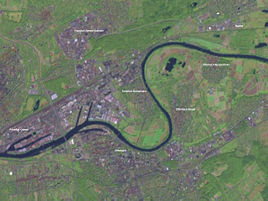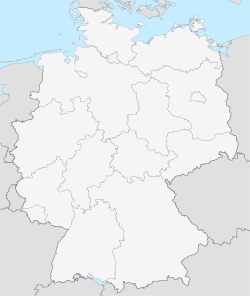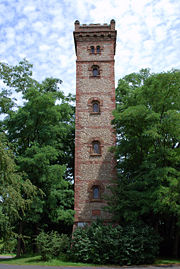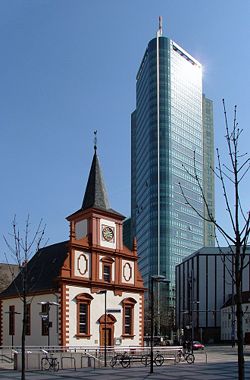Offenbach am Main
| Offenbach | |
 |
|
| Coat of arms | Location |
 |
 |
| Administration | |
| Country | Germany |
|---|---|
| State | Hesse |
| Admin. region | Darmstadt |
| District | Urban district |
| Mayor | Horst Schneider (SPD) |
| Basic statistics | |
| Area | 44.90 km² (17.3 sq mi) |
| Elevation | 62 m (203 ft) |
| Population | 117,546 (30/12/2006) |
| - Density | 2,618 /km² (6,780 /sq mi) |
| Other information | |
| Time zone | CET/CEST (UTC+1/+2) |
| Licence plate | OF |
| Postal codes | 63001 - 63075 |
| Area code | 069 |
| Website | www.offenbach.de |
Offenbach am Main is a city in Hesse, Germany, located on southside of the river Main. In 2006 it had a population of 116,923. The city is part of the Rhein-Main metropolitan area.

Offenbach was a center of the leather industry, which has however declined in the last decades. It is still the seat of the Deutsches Leder Museum (German Leather Museum), and also of the international leather fair. It is also the seat of the Deutscher Wetterdienst (German weather service). It is also home to the soccer club "Kickers Offenbach" and their stadium "Bieberer Berg".
Offenbach is part of the S-Bahn Rhein-Main-System with six S-Bahn stations: Offenbach-Kaiserlei, Offenbach-Ledermuseum, Offenbach-Marktplatz, Offenbach-Ost, Offenbach-Bieber, Bieber-Waldhof.
Contents |
History
The first documented reference to Offenbach appears in 977. In 1486 the Isenburgher Family took control of city, and 1556 Count Reinhard of Isenburg relocated his Residence to Offenbach, building a palace which was completed in 1559. It was destroyed by fire in 1564, rebuilt in 1578.
In the mid 1600s Offenbach passed into the possession of the landgraves of Hesse-Darmstadt who ruled it until the 1815 when the Congress of Vienna gave the city to the Austrian Emperor. A year later it was returned to the grand duchy of Hessen-Darmstadt. The city was ruled by Grand Dukes of Hesse and by Rhine until the monarchy was abolished in 1918.
During the Second World War a third of the city was destroyed by Allied bombing which claimed 467 lives.
With the new district Lauterborn the city was expanded to south in the 1960ies.
Incorporations
There following municipalities were incorporated into Offenbach:
| Year | Town | Area |
|---|---|---|
| 1908 | Bürgel | - |
| April 1 1938 | Bieber | - |
| April 4 1942 | Rumpenheim | - |
Economy
Until the early 1970s Offenbach was dominated by the machine-building and leather industries. The city hosts the German Association for Electrical, Electronic and Information Technologies to this day.
Offenbach was also the European center of typography, with Gebr. Klingspor and Linotype (inventors of Optima or Palatino typeface) moving to nearby Eschborn in the 1970s and MAN Roland printing machines still a major employer today. Typography and design still remain importants with a cluster of graphic design and industrial design companies, as well as the universitary level HfG Offenbach design school and the Klingspor Museum.
In recent years Offenbach has become a popular location for a wide array of services, especially from the transport sectors. Offenbach host to the European headquarters of Honda, Hyundai Motors and Kumho Tires.[1]



Main sights
Edifices
- Isenburg Palace, typical Renaissance building from 1576, now used by the Offenbach Design University
- Büsingpalais.
- Rumpenheim Castle.
- French Protestant Church and French Protestant Community.
- Westend Quarter (19th century).
- Several art deco apartment houses.
- Former Synagogue "Capitol" (now a concert hall).
- Buildings by early 20th century architect Hugo Eberhardt: "Heyne" Factory, main building of the Design University , AOK Insurance building.
- Prefabricated houses by Egon Eiermann in Lauterborn
- Soccer-stadium "Stadion Bieberer Berg".
Museums
- German Leather Museum
- Klingspor Museum, museum of typography and calligraphy
- Haus der Stadtgeschichte, municipal historical museum
Population history
| Year | Population |
|---|---|
| 1540 | 480 |
| 1680 | around 600 |
| 1790 | around 6,000 |
| 1834 | 9,433 |
| 1871 | 22,699 |
| 1890 | 35,064 |
| 1900 | 50,508 |
| 1910 | 75,583 |
| June 16, 1925 | 79,362 |
| June 16, 1933 | 81,329 |
| May 17, 1939 ¹ | 87,052 |
| September 13 1950 ¹ | 89,019 |
| August 18 1954 | 100,000 |
| June 6 1961 ¹ | 116,200 |
| May 27 1970 ¹ | 117,306 |
| June 30 1975 | 116,400 |
| June 30 1980 | 111,200 |
| June 20 1985 | 107,200 |
| May 27 1987 ¹ | 111,386 |
| June 30 1997 | 116,600 |
Offenbach has the highest percentage of foreign people throughout Germany.
Mayors of Offenbach from 1824
- 1824–1826: Peter Georg d'Orville
- 1826–1834: Heinrich Philipp Schwaner
- 1834–1837: Peter Georg d'Orville
- 1837–1849: Jonas Budden
- 1849–1859: Friedrich August Schäfer
- 1859–1867: Johann Heinrich Dick
- 1867–1874: Johann Martin Hirschmann
- 1874–1882: Hermann Stölting
- 1883–1907: Wilhelm Brink
- 1907–1919: Andreas Dullo
- 1919–1933: Max Granzin
- 1947–1949: Johannes Rebholz
- 1950–1957: Hans Klüber
- 1957–1974: Georg Dietrich
- 1974–1980: Walter Buckpesch
- 1980–1986: Walter Suermann
- 1986–1994: Wolfgang Reuter
- 1994–2006: Gerhard Grandtke
- 2006–: Horst Schneider
People
- Rabbi Abraham Bing
- Gottfried Böhm
- Moritz Wilhelm August Breidenbach
- Heinrich von Brentano
- Ray Bumatai, born here
- Thea Dorn
- Jacob Frank
- Prince Philipp of Hesse
- Karlgeorg Hoefer
- Hans Hotter
- Regina Jonas, first female Rabbi, ordained in Offenbach
- Heinrich Kaminski, worked here
- Rudolf Koch, worked and taught here
- Fritz Kredel, studied here
- Philipp Mainländer, died here
- Helene Mayer, born here
- Jacques Offenbach
- Götz Otto, born here
- Anthony Rother Electronic musician
- Snap!, German dance group
- Jan Trubecki
- Berthold Wolpe
- Pascal Behrenbruch, German decathlete.
Twinned cities
|
External links
- Offenbach website (German)
|
||||||||